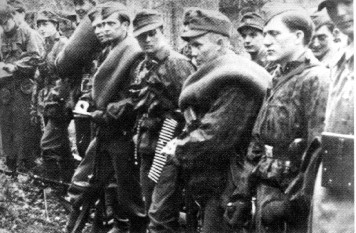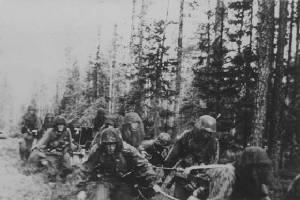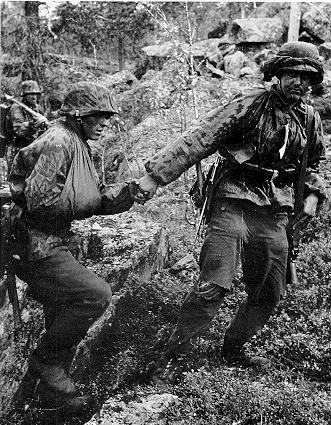|
Hitler's Northern Trouble Spot
When he launched his campaign
in Russia, Hitler had worried about the northernmost flank of that front stretched from Arctic Norway across Finland to the
northern reaches of Russia, an area known to cartographers as Lapland. He feared that the British would attack this place
and joined with the Russian from Murmansk to severing German lines with northern Finland and captured Petsamo and the Swedish
iron mines just east of Narvik. To prevent it, Hitler called for operation that would stop the Murmansk railroad to become a dangerous spot for his position.
The
German High Command created two operations to sever the Murmansk railroad. One of them dubbed as Polar Fox. According this plan, two division launched from the town of Rovaniemi in central Finland would strike
the Soviet strong point at Salla, then advance on the railhead at Kandalaksha, 220 miles south of Murmansk. As part of the
same operation, another two divisions - both of them Finnish - would simultaneously cross the border to the south, one to
help in the attack on Salla, and the other to cut the railroad at Loukhi.
The operation command was given to
Generalleutenant Hans Feige, a career officer with four decades experience, and Brigadier General Hjalmar Siilasvuo, the Finnish
hero of Soumussalmi. Feiges objective was to capture Salla - now held by a 20,000-man Soviet garrison - then drive on to Kandalaksha,
90 miles beyond, and cut the Murmansk railroad. Siilasvuo, meanwhile, would cover Feiges southern flank while leading a Finnish
advance on the railroad at Loukhi, 70 miles inside Soviet territory. Feige had 40,600 German troops for his part of the operations,
including an elite SS-Kampfgruppe 'Nord'.
He also commanded 12,000 men of the Finnish 6th Division. Siilasvuo commanded the Finnish III Corps, numbering another 12,000
men.
General Feige planned a four-pronged assault on Salla. One of his German regiments was to advance along the Kandalaksha-Salla
road for a direct attack on the garrison there; two more regiments would swing around Salla to hit it from the north, and
Kampfgruppe 'Nord' would attack from the south. Meanwhile, the Finnish 6th Division
would cross the Russian front 45 miles south of Salla and try to take the enemy from the rear.

|
| 'Nord' soldiers before the battle. |
The undertaking got off to a poor
start. The only one of Fieges groups that made any progress at all was the northern group, which advanced through the forest
and got about three miles into Soviet territory. The frontal attack was stopped 500 yards across the border and thrown back
by a Soviet counterattack. But the worst appearance comes from the supposed elite unit: SS-Kampfgruppe
'Nord'.
The Unlikely Crack Unit
SS-Kampfgruppe 'Nord', like all SS combat units, which were Hitler's favorites, was superbly equipped. It had two
infantry regiments, a machine-gun battalion, an antitank battalion, an artillery battalion, an engineer company, all completely
motorized and light-tank battalion. Unfortunately for the operation, the kampfgruppe abundance of up-to-date equipment was neutralized by a lack training.
Actually, SS-Kampgruppe 'Nord' was formed for security of the Murmansk Road
in Finnish Lappland. It members mainly came from former concentration camp guards and overage SS reservist. In June 1941,
when the kampfgruppe assigned to the Army Group North, its commander, SS-Brigadeführer Karl-Maria Demelhuber, announces to headquarters
that 'Nord' was unfit for combat due to lack of training: the officers had received no more than a short course of lectures
and demonstrations of combat tactics; the artillery battalion had fired its guns but once; even the infantrymen had scarcely
tried their weapons until their commanding general gave them a little target practice en route to the Russian front. Their
rawness was to be a terrible handicap.
Demelhuber requests 2-3 additional
months for training before committing to combat. Unfortunately, his request was denies. The SS Command, especially Reichsführer-SS Himmler, believed that 'Nord' men's
high moral and firm determination and the fact that they were motorized would overcome their military shortcomings. After all, they were the master race
and their's enemy were only sub-humans. These wrong assumptions lead the unit into a disaster.
The Disaster
On 6 June SS-Kampfgruppe 'Nord' was ordered to the Rovaniemi area of Finland for participation in the upcoming invasion
of the Soviet Union. The kampfgruppe had only recently concentrated near Kirkenes
and had to march the length of the Arctic Ocean Highway from Kirkenes on the Arctic Ocean to Rovaniemi not far from the Baltic
Sea. By 10 June its forward elements had reached their destination and then began moving towards the Soviet frontier near
Salla on 17 June along the single road allocated to 'Nord'.
The order to attack didn't arrive until 24 June,
but the actual date of the attack wasn't set until 1 July. 'Nord' was to make a frontal attack on the Soviet positions in
front of Salla while the 169. Infanterie Division attacked on their northern flank
and the 6th Finnish Infantry Division was to drive deep behind the Soviet 122nd Rifle Division to Allakurtti from the southern
flank. 'Nord' was reinforced with most of Panzer Abteilung 40 while Artillerie Abteilung.496 and 520 provided indirect fire
support. Stukas of IV.(St.)/LG 1 were to suppress Soviet artillery positions before the assault.

|
| 'Nord' soldiers attacking Salla. |
This opening barrage had
some effect on the defenders, but more importantly set much of the forest on fire, which severely degraded visibility for
the Stukas and artillery observers. The fire also prevented the regimental
heavy weapons from supporting the infantry with direct fire on Soviet positions. The infantry was unable to advance very far.
The German advance was stopped in its tracks by the Soviet border fortifications.
At the first sight
of the Russians, some of the green troops of 'Nord' lost heart: they threw away their weapons and fled in panic or surrendered. Eventually they fell off in such numbers
that the Soviets were able to leave them and concentrate on the other two groups to the north. The
resulting three-day battle set the wood aflame, and Feige and his experience troops had all they could do to hold their ground.
Feige finally got his center regiment moving
and broke through the first line of defenses around Salla. Meanwhile, the 'Nord' regrouped during the 2nd and 3rd in preparation
for the resumption of the attack on the 4th. However, the Soviets struck first at 0100 on the 4th with tanks in SS-IR 7's
sector. The SS men bolted once more, and this time their fright led them to stampede. The men poured
down the road toward Kemijaervi, shouting that Russian tanks were at their heels and
that the bridges across the Kerni River had to be blown. Feige and his staffs stationed themselves
across the roadway and spent several difficult hours getting as many careering vehicles and panicked men halted and turned
around as they could. Some vehicles broke through their roadblock and raced all the way to Kemijaervi, 50 miles to the west.
The flight of the
'Nord' men had left Feige with a gap in his force. The situation only was being saved by the action of the Finns and an army
division. General von Falkenhorst, German commanding general of the theater,
having lost faith in the fighting of the kampfgruppe divided its battalions among his Finnish and German Army formations. For Feige and von Falkenhorst, the poor
performance of 'Nord' was simply confirmed once and for all that the SS troops were wholly unreliable.

|
| 'Nord' stragglers in the woods. |
At last, on July 6, Feige resumed
his advance on Salla. The 169.Infanterie Division,
supported by two panzer companies, began attacking and by midday had reached Salla. The two armoured companies lost
most of their tanks but had knocked out 16 Soviet ones within a hour. By 17:00 hours the town was captured, but the Germans
were immediately thrown back by fierce Russian counterattacks. It was only through a Russian retreat eastwards that Salla
was captured by the morning of 8 July. Most of the Soviet 122nd Division had escaped, but had left most of its artillery behind
and all its 50 tanks were destroyed. The corps was proud to have captured Salla and inflicted such a stinging defeat upon
the enemy, but von Falkenhorst commented sarcastically that the positions that SS 'Nord' had confronted could have been taken
by raw recruits (von Falkenhorst's comments were quite unfair).
Aftermath
SS-Kampfgruppe
'Nord' first taste of the combat had cost it 73 killed and 232 wounded. Another 147 were missing. The losses themselves were
comparatively minor. But it breakdown Himmler's pride. Slowly and difficulty, the Reichsführer-SS faced up to facts. The Army commanders had not been entirely
wrong in saying that the Waffen SS lacked sufficient military training and experience. He also admitted that the Russians,
inferior though they were, fought on "like some prehistoric monster caught in a net".
The 'Nord' itself slowly and painfully had to learn
proper tactics at the front-line. Then, becomes a mountain division, they spend the remaining years of war from front to front
as Führer's fire brigade. But at the
end they were swallowed by Allied high tides.
|



